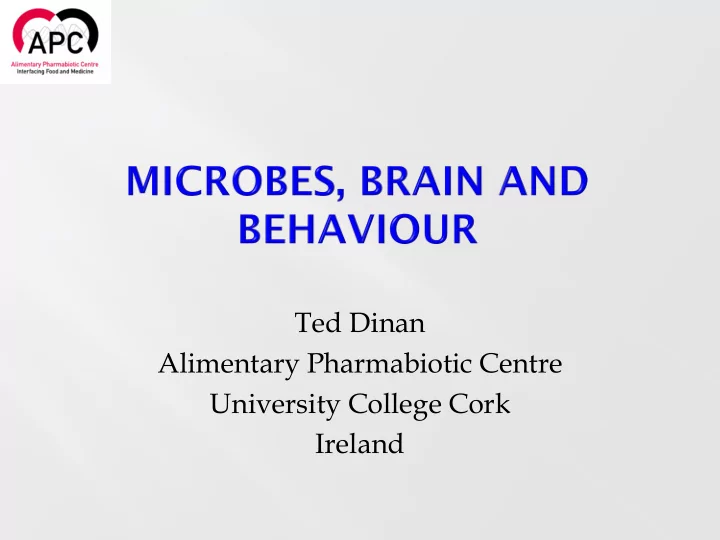

Ted Dinan Alimentary Pharmabiotic Centre University College Cork Ireland
Cryan & Dinan, Nature Nurosci Rev 2012
Cryan and Dinan, Nature Neurosci Rev (2012)
Subclinical infection with Campylobacter jejuni results in anxiety behaviour (Lyte et al, 1998) Walkerton study.. contamination of municipal water by Escherichia coli 0157:H7 and Campylobacter species
Minocycline has broad spectrum activity against both gram positive and gram negative organisms Novel therapeutic targets in depression: minocycline as a candidate treatment. Behav Brain Res 2012 Successful use of add-on minocycline for treatment of persistent negative symptoms in schizophrenia. J Neuropsychiatry Clin Neurosci. 2013
? Neurodegenerative disorders ? Neurodevelopmental disorders T.J. Borody and A. Khoruts Nat Rev Gastroenterol Hepatol. 2011
Germ-free in early life – effects on the social brain? Microbiome-gut-brain axis Germ-free mouse Altered gut - brain communication ? ↓ memory Altered social behaviours?? ↑ brain serotonin
BDNF is a neurotrophin supporting neuronal survival/growth Decreased BDNF in germ free compared to control animals Corticosterone Control 250000 Germ Free 200000 ** Altered stress response 150000 pg/ml 100000 50000 0 Baseline Stress Grenham et al., 2011
Hippocampus 5-HT Control ** Germ free Elevated 600 500 concentrations of 5- ng/g tissue 400 HT in hippocampus 300 of germ free 200 100 animals 0 Brainstem 5-HIAA/5-HT Control ** Germ free 1.00 Increased 5-HT 0.75 turnover in Ratio 0.50 brainstem 0.25 0.00 Clarke et al, 2012
Habituation : exploration of 3 chambered box (10 mins). 1 . Sociability : does the test mouse spend more time in the chamber containing the mouse or in the opposite empty chamber? 2 . Social novelty preference : does the test Familiar Novel mouse spend more time in the chamber containing the now familiar mouse or in the 3 . opposite chamber containing a new ‘strange’ mouse? Desbonnet et al, Mol Psychiatry 2013
Mouse Empty Sociability *** 350 Empty ** 300 * Mouse 250 * * Time (s) 200 150 100 Conventional 50 0 C GF GFR C GF GFR Female Male Germ Free
Novel Familiar Preference for social novelty 350 *** Familiar * 300 Novel 250 Time (s) 200 150 100 Conventional 50 0 C GF GFR C GF GFR Female Male Germ Free
400-500 species including: Bacteroides Eubacterium Peptostreptococcus Bifidobacterium Ruminococcus Bacillus Jejunum: 10 3-4 Fusobacterium Clostridium Lactobacillus Enterococcus Terminal Ileum: 10 7-9 Enterobacter Ana naer erobes es >> >> Aer erobes Colon: 10 10-12 Many bacteria remain unculturable…….?15% 5
Norepinephrine: Escherichia, Bacillus, and Saccharomyces Serotonin: Streptococcus, Escherichia, and Enterococcus Dopamine: Bacillus and Serratia Roschina, 2010
o Lactobacillus acidophilus strain modulates expression of cannabinoid receptors in the spinal cord Bif. Infantis increases plasma tryptophan levels and thereby modulates 5HT Lactobacillus rhamnosus alters central GABA receptor expression
Lactobacillus strain, GABA receptor expression and behaviour Bravo et al, PNAS, 2011
Bravo et al, PNAS, 2011
Effects of Vagotomy Bravo et al, PNAS, 2011
Can probiotic ingestion affect brain function in humans? • 45 Healthy women – Age 18-50 (mean age 29 years) – No gastrointestinal symptoms – No chronic pain – No psychiatric illness – No probiotic or antibiotic use in the last month Test product (n= 15) Commercially available fermented milk product (FMPP) 125 grams twice/day for 4 weeks Non- fermented dairy product (n= 12) 125 grams twice/day for 4 weeks No treatment (n=14) Tillisch, et al, Gastroenterology 2013
Network crossblock covariance 49%, P <.005 1 Across visits the network Pre-post TX change in 0 becomes: network (design score) NO TX CONTROL Test Product stronger with no treatment • -1 stays the same with control • decreased in Test Product. • -2 Tillisch, et al, Gastroenterology 2013
REVIEW BIOLOGICAL PSYCHIATRY 2013 Psychobiotics: A Novel Class of Psychotropic Timothy G. Dinan, Catherine Stanton, and John F. Cryan Here, we define a psychobiotic as a live organism that, when ingested in adequate amounts, produces a health benefit in patients suffering from psychiatric illness. As a class of probiotic, these bacteria are capable of producing and delivering neuroactive substances such as gamma-aminobutyric acid and serotonin, which act on the brain-gut axis. Preclinical evaluation in rodents suggests that certain psychobiotics possess antidepressant or anxiolytic activity. Effects may be mediated via the vagus nerve, spinal cord, or neuroendocrine systems. So far, psychobiotics have been most extensively studied in a liaison psychiatric setting in patients with irritable bowel syndrome, where positive benefits have been reported for a number of organisms including Bifidobacterium infantis. Evidence is emerging of benefits in alleviating symptoms of depression and in chronic fatigue syndrome. Such benefits may be related to the antiinflammatory actions of certain psychobiotics and a capacity to reduce hypothalamic-pituitary-adrenal axis activity. Results from large scale placebo- controlled studies are awaited.
? Depression/Anxiety L. helveticus together with B. longum ↓ psychological distress relative to placebo and ↓ urinary free cortisol output ( Messaoudi et al, 2011) ? Chronic fatigue syndrome ↓ anxiety in those given L. casei relative to placebo ( Rao et al, 2009) Irritable bowel syndrome (Whelan & Quigley, 2013)
Paucity of human studies • Which route of communication between gut • microbes and brain is most important in man? Do patients with psychiatric illness have a • distinct microbiota fingerprint? Do probiotics produce an • anxiolytic/antidepressant effects in humans that have been reported in rodents?
Strategy for Identifying Psychobiotics 1. Establish a library of putative probiotics 2. Culture and obtain supernatants 3. Subject supernatants to GC/MS and identify probiotics producing neuroactive compounds 4. Examine supernatant action on neuronal cell lines 5. Determine viability on gastric transit 6. Examine probiotic in animal models 7. Human intervention studies
How do probiotics alter stress related behaviour?
Recommend
More recommend